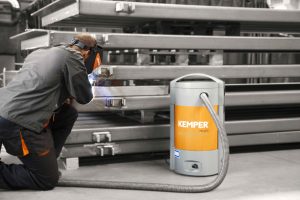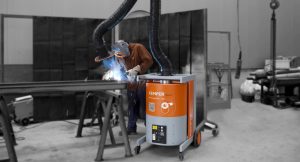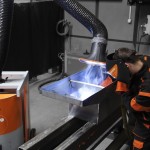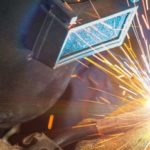Mobile suction units: 12 facts to help you select the right one
For many businesses, mobile suction units are the chosen means for extracting welding smoke. Especially in the case of changing workplaces, the spot extractors on rollers bring benefits as compared to stationary systems. The model that it makes sense to use depends on the location of use and on the intensity of welding. 12 facts that welders must pay attention to when selecting mobile suction units.
Mobile suction units are, to this day, the most frequently used systems in welding smoke extraction in small welding shops and in medium-sized workshops. The suction unit that is suitable for use in your own business depends mainly on three factors: the intensity of welding, the welding procedure and the materials being processed. But other questions, such as those related to the spatial conditions, also play a role.
- Mobile suction units ensure flexibility
In matters of work safety, flexibility in the handling of suction units is decisive. If welders often change their workplaces in production, they can simply take mobile suction units, on integrated rollers, along with them. Therefore, they are not tied down in the same way that they are with stationary suction units.
- Space must be available for mobile suction units
As opposed to stationary suction units, their mobile counterparts are placed on the floor. Stationary units have the advantage that they save space in the production area by being mounted on the wall. Therefore mobile suction units need more space, so that they can be movable at all.
Often, businesses do not have the space at all, and therefore they need to install a central suction unit with spot extractors in several workplaces. Mobile suction units are therefore the optimal solution between stationary suction units and central suction systems. The range of application for mobile suction devices is, in the same way as with their stationary counterparts, also limited by the use of the system; however, like central systems, they can be used in various workplaces.
- Designs for two workplaces are also available
If, however, the simultaneous use by several welders is desirable, for mobile devices there are already alsodesigns, with which two welders can simultaneously weld and still experience the same level of work safety (or here).
- Flexible suction arms ensure free movement
Mobile suction units with integrated suction arms are the most common. These are in demand especially because of the flexibility of their arms. In ideal situations they can simply be rotated by 360 degrees, with one hand, during the welding process and independently stay in the individually specified position. A flange-type structure of the connected suction hose ensures a larger suction range and less tracking. Along the weld seam, it captures the welding smoke in a larger area. An LED light that is integrated in the suction hood thereby improves the visibility of the workpiece. Because the suction arms are available in different lengths, they can also be adapted to different work environments.
- Units should be directly tested by W3
In the best case, mobile suction units should be certified directly according to W3. With permission of the Institut für Arbeitsschutz der Deutschen Gesetzlichen Unfallversicherung (Institute for Occupational Safety and Health of the German Social Accident Insurance, IFA) they have then also been approved for the welding of chromium-nickel steels. In this process, carcinogenic particles are released. W3 also represents the highest filtration efficiency of more than 99 percent even for the very fine welding smoke particles, which can almost exclusively enter the alveoli (the lungs) and have sizes of 0.4 µm and smaller.
- The welding process and material are decisive in the selection
Whilst an entry-level model is sufficient for sporadic TIG welding, for sporadic filled-wire welding, a higher-performance suction unit is necessary. Something similar applies to high-alloy steels: In sporadic TIG welding an entry-level model is sufficient, but during longer-term filled-wire welding, even a suction unit with a cleanable filter is recommended.
- Suction rates vary, mainly due to the filter surface
Entry-level models for sporadic welding have smaller filter surfaces as compared to higher-performance suction units. The quality of the suction units thereby increases with the size of the filter surface. While devices for occasional welding can make do with surfaces of around 17 square meters, higher-performance suction units have filter surfaces of around 42 square meters. This makes them suitable for regular welding. This has a reason: The larger the filter surface, the more slowly the air flows through the filter medium. As opposed to the situation with filter surfaces that are too small, particles form an open-pore filter cake with the filter medium. There, the air can continue to flow through and the useful life of the filter is extended.
- Filter technology: Single-use or cleanable
If businesses do long-term welding, which entails large quantities of welding smoke, then suction units with cleanable filters are the most suitable. As the name says, the device cleans the filter, automatically when possible, so that the dust can be disposed of separately. The supply of compressed air is necessary for the operation of suction units with cleanable filters. In return, businesses save on regularly having to change the filtration material, as they have to do with single-use filters, and they thereby also save on ongoing subsequent costs.
- Contamination-free disposal is today more important than ever
Mobile suction units should have contamination-free disposal whenever possible. Regardless of whether single-use or cleanable filters are used: Employees should not come into contact with the hazardous substances, even after extraction.
- Transportable suction unit for external contracts
 For example, during maintenance, but also in the case of other contracts, which are completed outside of your own production areas, the availability of effective work protection on site is an issue that often arises. Suction units are also available in highly mobile dimensions. Whilst transporting the mobile suction units with suction arms would be too cumbersome, these systems, thanks to their low weights, can easily be moved manually to the place of use, or they can be transported on a trolley. They are also suitable for suction with integrated welding torches – when used in this way, the air is suctioned directly at the welding torch. As a rule, however, welders use them as a design with a hose and a funnel-shaped suction nozzle. This suction unit is positioned very close to the point where the welding smoke is generated, through the use of magnets, and due to the small nozzle opening. As compared to mobile suction units with suction arms and hoods, however, more tracing is necessary here.
For example, during maintenance, but also in the case of other contracts, which are completed outside of your own production areas, the availability of effective work protection on site is an issue that often arises. Suction units are also available in highly mobile dimensions. Whilst transporting the mobile suction units with suction arms would be too cumbersome, these systems, thanks to their low weights, can easily be moved manually to the place of use, or they can be transported on a trolley. They are also suitable for suction with integrated welding torches – when used in this way, the air is suctioned directly at the welding torch. As a rule, however, welders use them as a design with a hose and a funnel-shaped suction nozzle. This suction unit is positioned very close to the point where the welding smoke is generated, through the use of magnets, and due to the small nozzle opening. As compared to mobile suction units with suction arms and hoods, however, more tracing is necessary here.
- Suction units for sporadic welding are available cheaply
Of course, finances also play an important role in the purchasing decision. Mobile suction units for sporadic welding are available from around 1,000 Euro. The increase in price then depends on the performance of the mobile suction unit and the accessories (e.g. The length of the suction arms).






